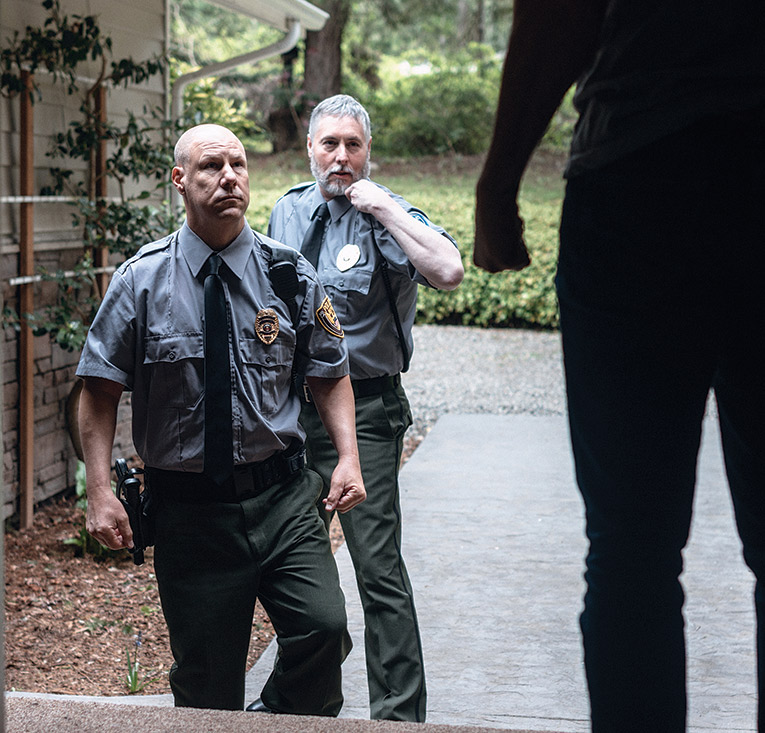JON GENTILE
Sergeant, LVMPD
 Officers today are faced with more challenges than ever in terms of violence against officers, conflict with authority and public scrutiny. One of the most frequent areas of scrutiny has come in the form of officer-involved shootings and lethal force. This article will touch on that, as our focus will be your encounter against a subject with an edged weapon. This article will provide insight into some of the things officers should be thinking about in that situation.
Officers today are faced with more challenges than ever in terms of violence against officers, conflict with authority and public scrutiny. One of the most frequent areas of scrutiny has come in the form of officer-involved shootings and lethal force. This article will touch on that, as our focus will be your encounter against a subject with an edged weapon. This article will provide insight into some of the things officers should be thinking about in that situation.
Knives and Other Weapons
Whether on a domestic violence call, suicide attempt or something as simple as a person stop for a violation, the existence of a knife or other weapon has to be considered. You might be in a home on a call, and it may lend someone access to grabbing a household item such as a bottle, ashtray, screwdriver, wrench or steak knife, just to name a few. Knives or other tools can be made into formidable weapons and can be concealed. They are cheap, don’t require a license to buy and can immediately be deployed if you are sloppy with your tactics.
Officer Considerations and Tactics
 An edged weapon can be thrown; however, statistically, most of the time the attacker prefers to control the knife and make it up close and personal. That is where it does the most damage.
An edged weapon can be thrown; however, statistically, most of the time the attacker prefers to control the knife and make it up close and personal. That is where it does the most damage.
Words like the 21-foot rule come to mind when we officers think of edged-weapon attacks. Simply put, this rule was a guideline of how much ground a knife-wielding attacker could cover to successfully attack an officer from a holstered weapon position. While some have debated about whether this is realistic or unrealistic, we have developed tactics to give an officer a better advantage. A key component to an officer’s defense and survival is being aware and reacting right away to the threat.
Pat-Downs for Weapons
One way of taking a knife or other homemade weapon out of the equation is to articulate a pat-down for weapons, also known as reasonable suspicion. That is exactly what it is, and through training and experience, you may be able to detect a weapon on the person and ensure a safe stop or encounter. This is a prudent practice if you are handling an interview in the field, an in-custody situation, or an investigation where you’re in someone’s home. There are lots of places to hide a weapon. It could be on one’s person, in a purse, or inside a vehicle or home. Be methodical when doing your pat-down.
Distance
When an attack is presented, creating distance, having an awareness of the threat and putting something in between you and the attacker are good actions. The reactionary gap is basically the time it takes you to react to an immediate threat. In that time, you need to figure where you’re at and ask yourself: Can you move out of the path of the would-be attacker, will he or she drop the knife on your command, can you draw your weapon and stop the threat, what is your backdrop like, is there a crossfire situation, etc.? As you can tell, there are a lot of things to consider in a fraction of a second.
Suicidal/Mentally Ill Subjects
Time and time again, especially with all the national media exposure and copycats, there seems to be an increase in suicidal subjects threatening to kill people, themselves, or put themselves in situations where officers are forced to shoot them, which is known as suicide by cop. Here are some of the considerations in such a scenario.
• What kind of firearm or rifle does the subject have?
• What is his/her weapon/knife and distance?
• Have you communicated to other incoming officers about where the subject is located?
• Are you at a safe distance, and do you have cover?
• Are you communicating with the subject? Is there a CIT officer available? Is the person talkative, passive or aggressive?
• Have you isolated the subject from others to minimize exposure?
• If there is more than one officer, do you have less-than-lethal options available?
• If you can calm the subject down and make them give up, do you have a custody plan in place?
• What is your backdrop like, if lethal force becomes the only option?
• Ensure there is no crossfire with other units.
• Have medical nearby.
• Have you trained enough for this scenario?
• Were your actions (use of force) objectively reasonable given the totality of the circumstances?
As you can see, you can interject some of your own ideas and experiences into the plan and maybe add a few more things to that list.
Summary
In summary, officers encountering suspects on a daily basis need to keep their awareness levels up in case of a violent encounter. It is said that experience enables one to get a better read on whether or not a subject gets into the “fight or flight” mode. If the subject is close, you have to not only be alert, you have to have your hands up and be ready for whatever comes your way. Defensive tactics in the form of empty-hand techniques may be the only thing you have at that moment and time when all hell breaks loose. Avoiding complacency and having good tactics will ensure that you will have a higher success rate through a major incident. It’s not a question of if, but rather when it will take place. Train it, learn it, and talk about it with your partner and squad. Empty-hand tactics should not be your primary tactic against a knife, so be familiar with yourself, train, know your environment, know what you can do, and know your duty belt and the weapons you have on it.
Be safe out there.
Sergeant Jon Gentile has over 26 years with LVMPD and has been a defensive tactics instructor for 24 years. Jon has trained in the martial arts for over 35 years and has practiced Filipino Kali (edged-weapon-based martial arts) for the past 20.

